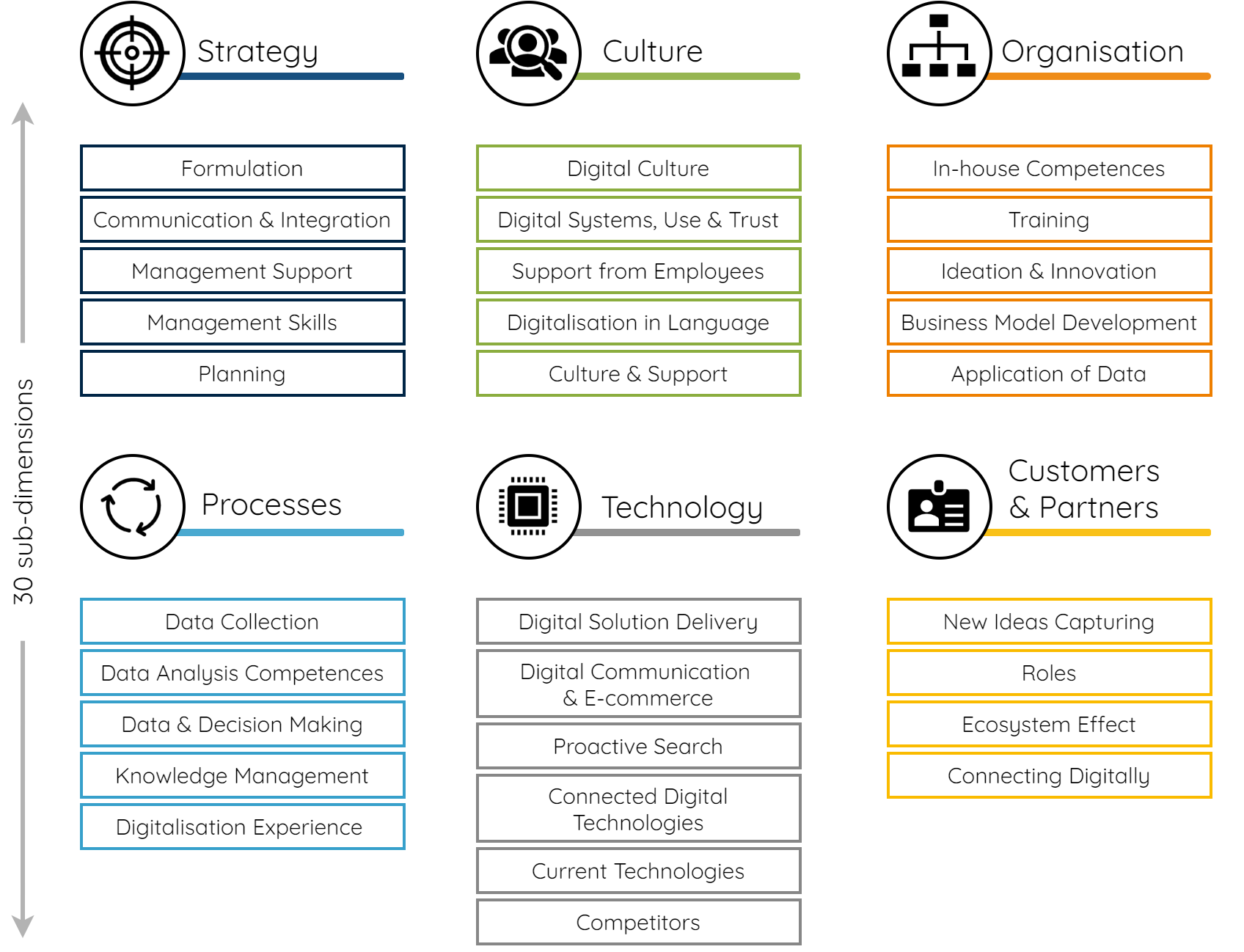The six dimensions in detail
The DMAT assesses digital maturity on six clearly defined dimensions to create a holistic view across the organisation. Each of the six dimensions constitute a number of key sub dimensions that are applied in getting the full picture of your companies digital strategy, culture, organisation, processes, technologies, partners and customers.

Strategy
The strategy dimension focuses on identifying the role of digitalisation in the business strategy.
Here, two primary questions are raised: How is digitalisation currently perceived in the organisation and does the organisation have a clear and coherent business strategy for digital transformation.
The former is assessed by determining a) if digitalisation is a core element of the organisation’s future strategic business development, provided that management has the necessary skills to implement digitalisation, and b) your organisation’s future digital prospects. The latter is assessed by determining if the digital business strategy is logical, consistent, easy to understand, perceive and interpret, and if it is well communicated and integrated across the organisation.
Culture
The culture dimension focuses on identifying the extent of digitalisation in the organisational culture. Questions on cultural adoption are raised at both employee and managerial level. The former is assessed by determining if the employees support the digital development, and if they actively use and trust data from the organisation’s digital systems. The latter is assessed by determining if management actively supports a digital growth culture and to what extent digital technologies and digitalisation are part of the corporate language and dialogue across the organisation.
Organisation
The organisation dimension focuses on identifying how digitalisation is cultivated throughout the organisation. Questions are raised in relation to present capabilities as well as activities nurturing digital initiatives in the organisation. The former is assessed by determining if the organisation has in-house competences to create and capture data, and if employees receive the necessary training in how to use digital systems and digital processes. The latter is assessed by deciding which actions and ideas for new digital activities are to be initiated and whether new business areas and models are to be developed using data and data analytics.
Processes
The processes dimension focuses on identifying how digitalisation contributes to the organisation. Questions are raised in relation to the organisation’s processes and the implementation of these. The former is assessed by determining if the organisation has competences and systems to analyse data and if employees have sufficient knowledge of the organisation’s digital systems. The latter is assessed by determining if data are applied in a structured way in the organisation and if data are used by employees and management to make more informed decisions.
Technology
The technology dimension focuses on identifying the ways in which technology is incorporated in the current organisation. This dimension questions whether the company provides digital solutions in its products and services to customers and whether digital communication and e-commerce are applied. In addition, the dimension looks at whether the company is actively seeking knowledge about new technologies to support digital business development and whether the company connects digital technologies to collect data.
Customers and partners
The customers and partners dimension focuses on identifying the role of customers and partners in the company’s digital business development. Questions are raised in relation to whether actions and ideas for new digital initiatives generated by customers and partners are captured, and whether the impact on the ecosystem is taken into account. Finally, the dimension questions whether the organisation connects with customers and partners digitally to collect data across the value chain for optimisation and development.

The research behind DMAT
In the below video session, Annabeth Aagaard, lead researcher on the DMAT and Associate professor, PhD and Centre Director of the Interdisciplinary Centre for Digital Business Development, Aarhus University, presents the tool at the Digital Around the World Conference – a 24 hours non-stop virtual conference that brings together innovators, researchers, developers, politicians and civil society actors to discuss the latest trends in digital transformation.
The 10-minute video informs about digital maturity as concept, how it relates to business performance and the barriers for adopting digital maturity and leveraging digital technologies. Annabeth Aagaard touches upon the underlying research for developing the DMAT, and the idea of using a tool for assessing digital maturity, as well as she elaborates the six dimensions of DMAT and how to use the tool.
For questions regarding the research behind the DMAT and/or to take part in a research project on digital maturity with BTECH, Aarhus University and The Interdisciplinary Centre for Digital Business Development, please contact Annabeth Aagaard.